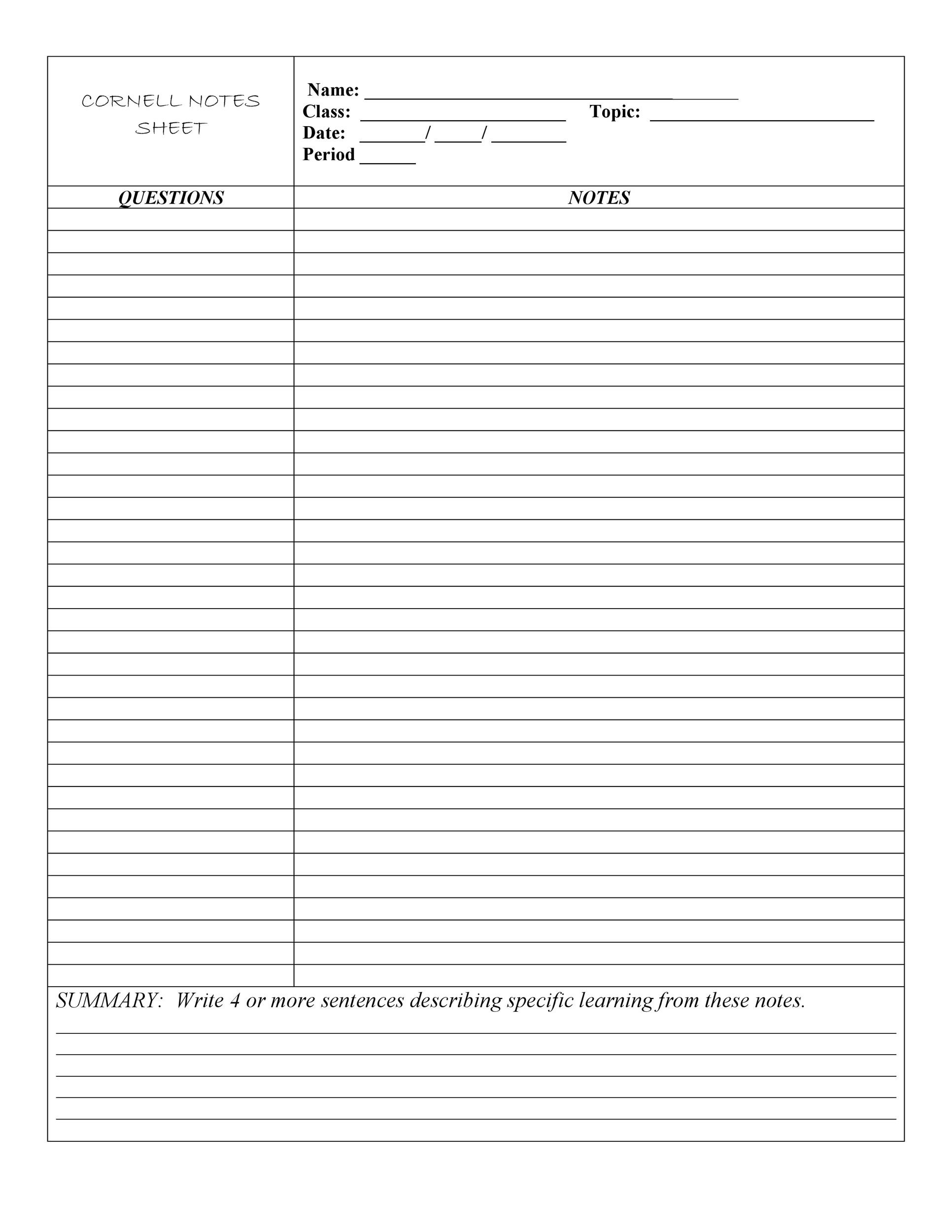by Gina Trapani
- Cornell Note Taking Method Custom Pdf Generator Free Online
- Cornell Note Taking Method Custom Pdf Generator Free Printable
- Cornell Note Taking Examples
- Cornell Note Taking Template
Cornell Notetaking Method Custom PDF Generator September 15, 2005. Cornell Notetaking Method Custom PDF Generator. Make your own note paper. DIY Ultimate Note-Taking. The Cornell Method is a powerful note taking technique which separates a piece of paper. Cornell Note-Taking Paper. The Cornell note-taking system provides a format for condensing. Custom URL and branding; Free 30 day trial. The authority on APA Style and the 6th edition of the APA Publication Manual. Find tutorials, the APA Style Blog, how to format papers in APA Style. Cornell Notes – Word Template. The Cornell Notes method is one of the most popular. Overview of Cornell Note-taking System; Cornell Notes PDF Generator. Cornell Note Pdf. Free Cornell Note Template 5 Free Word Excel PDF Format Download Free Premium Templates. Tips For Using The Cornell Note Taking Method Law School Toolbox. Cornell Note Taking Method Custom Pdf Generator For Mac Prioritycode.
Copying class notes after the fact is a time-consuming way to study for an exam, but it was the only thing that truly worked for me back in college. But next week I'll be in a classroom again for the first time in 8 years, pen poised over notebook, and this time I'm going to perfect a strategy that gets my notes right the first time: the Cornell Note-taking method.
Advertisement
We've mentioned the Cornell method in passing here and there, but today we'll dive deep into how to transcribe a lecture in a way that makes studying and cross-references a breeze throughout the semester - no copying involved.
Cornell Notetaking Method
I wish I'd had a system in place for my own notetaking when I was a student. The Cornell…
Read more ReadAdvertisement
Lay out your page for the Cornell Method
Cornell Note Taking Method Custom Pdf Generator Free Online
Using the Cornell method, you split your notes page into three sections, as shown below.
Advertisement
- Notes column (right) Record the lecture here during class using short sentences and fragments that transcribe the facts you'll need. Eliminate all unnecessary words. Use bulleted lists for easy skimming, and as much shorthand as possible (without sacrificing readability.) Develop a vocabulary of abbreviations you always use, like 'ex' for 'for example,' 'v.' for 'very,' 'tho' for 'though,' '1st' and '2nd' for 'first and second.' Finally, leave lots of whitespace between points and paragraphs so you can go back and fill in sections later.
- Cues column (left) After class, review your notes and jot questions and memory joggers in this narrow column that help connect ideas listed in the notes section. When you're studying, you will look at these cues to help you recall the salient facts in your notes, so keep that in mind when you create your cues.
- Summary area (bottom) After class while you create your cues, sum up the notes on each page in one or two sentences that encapsulate the main ideas in the bottom area. You'll use the summary section to skim through your notes and find information later.
Advertisement
An example of a page of notes taken with the Cornell method, shamelessly ripped off from a Temple University page, is shown below. (Click to enlarge.)

Advertisement
Study and review your Cornell-formatted notes
The Cornell Note-taking method's creator, Walter Pauk, outlined a six-step study system to use along with this note format. The BYU web site breaks down the 6 R's: Record, Reduce, Recite, Reflect, Review and Recapitulate. While those steps are worth a read, personally I think this system boils down even further.
Advertisement
In short, once you've attended class and filled in the notes area, that evening, review them and fill in the cues and summary area. When the time comes to study for an exam, read through your notes. To quiz yourself, cover up the right side and use the cues on the left to jog your memory and help you rebuild the factual narrative in your mind. When you've got a paper to write, use the summary section of each notes page to flip through and find relevant facts to cite in your paper.
In essence, with the Cornell method, instead of straight transcription, you're creating your study guide as you go instead of waiting till it's time to cram for the test.
Advertisement
Cornell Note Taking Method Custom Pdf Generator Free Printable
Pre-formatted Cornell Notepaper

Unless you like messing around with a ruler and pen or pencil, there are a few templates and notepaper generators that will print out pre-formatted Cornell notes-style pages. Two mentionables include:
- The Cornell Method PDF Generator creates printable PDF's split into the Cornell notepaper style with unlined, ruled, or graphed sections. Optionally include your name, the date, and the name of your class, and up to 4 punch holes for use in a binder. Also, choose the line darkness on a scale from gray to black.
- Cornell Word Templates are perfect for students who take their notes with Microsoft Word. This page includes instructions for creating your own Word Cornell template, and a sample you can tweak to your own needs.

Advertisement
How are you taking notes this semester? Had any good or bad experiences with the Cornell method? Let us know in the comments.
Gina Trapani, the editor of Lifehacker, is sharpening her Ticonderoga Number 2's for class. Her semi-weekly feature, Geek to Live, appears every Wednesday and Friday on Lifehacker. Subscribe to the Geek to Live feed to get new installments in your newsreader.
Cornell Note Taking Examples
Advertisement
Cornell Note Taking Template
Note-Taking Methods > Cornell Method
|